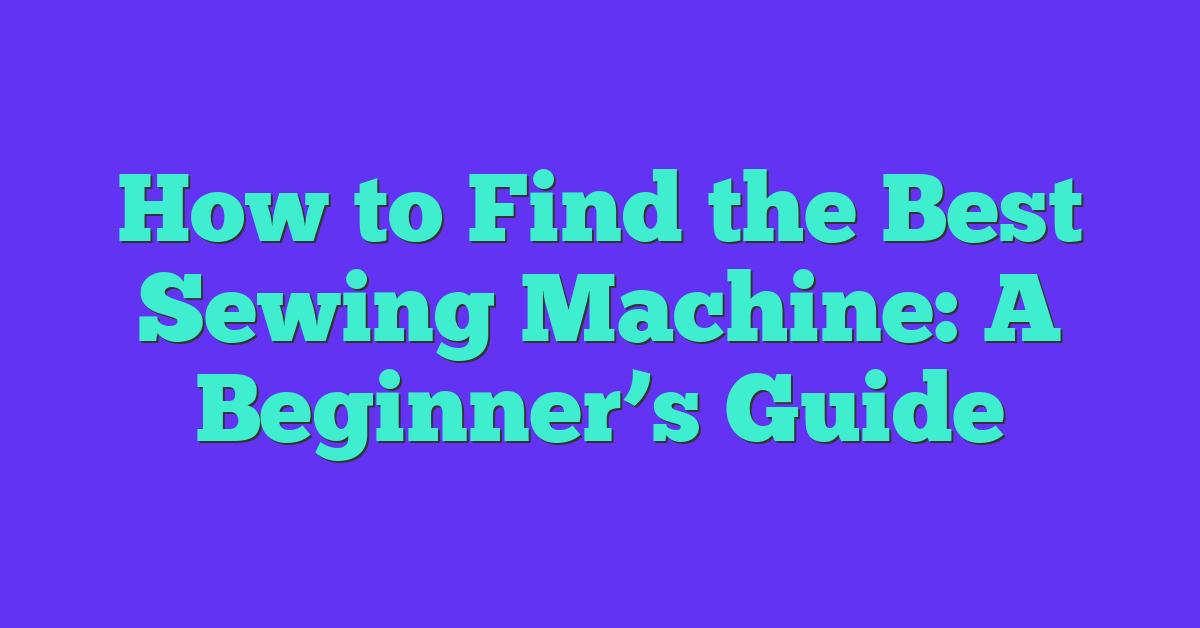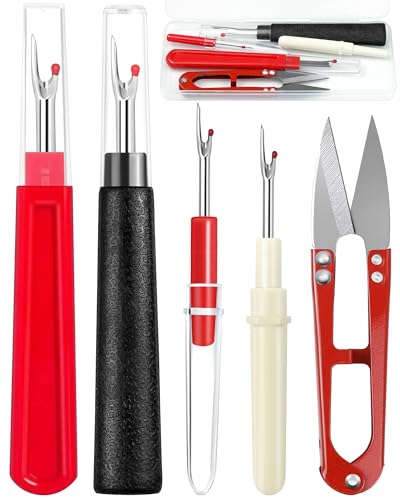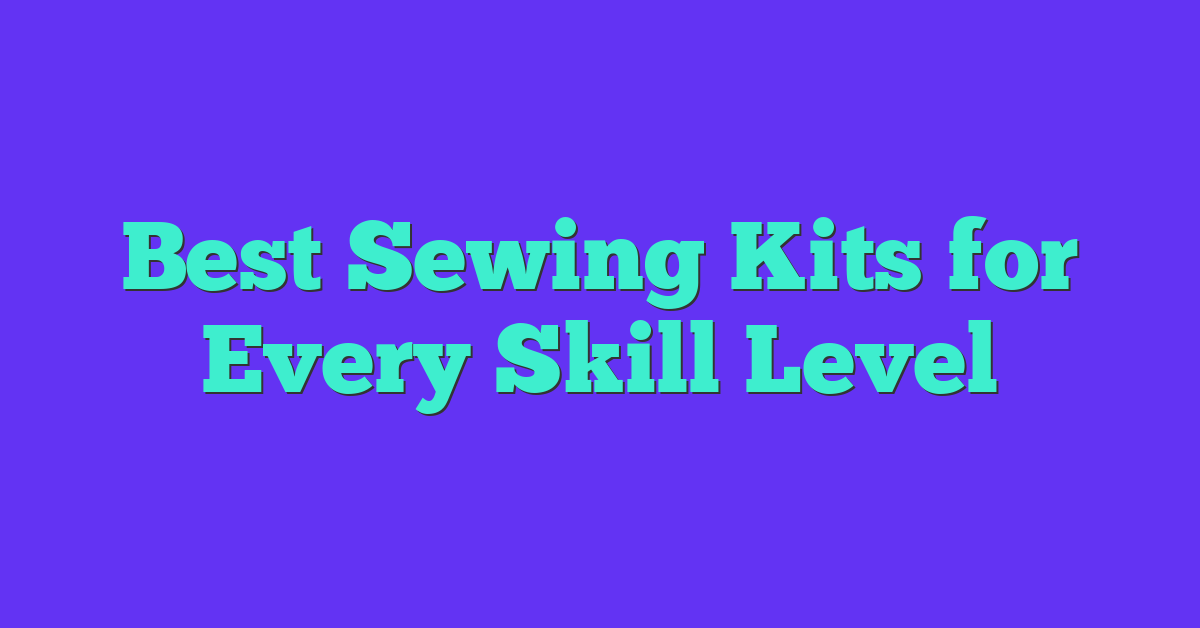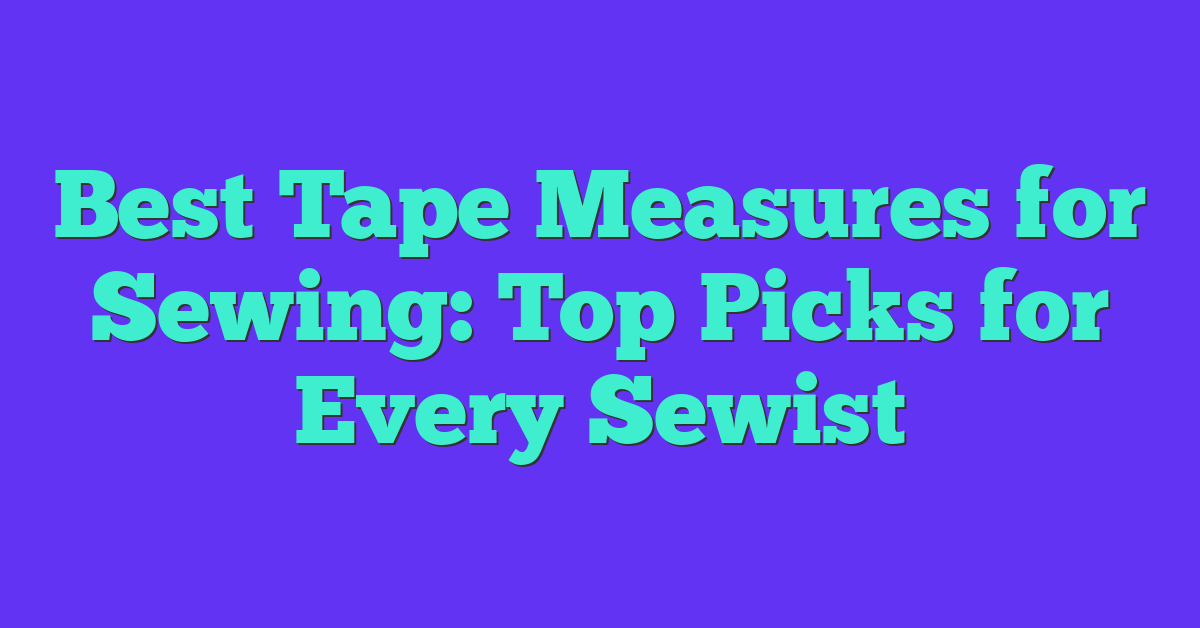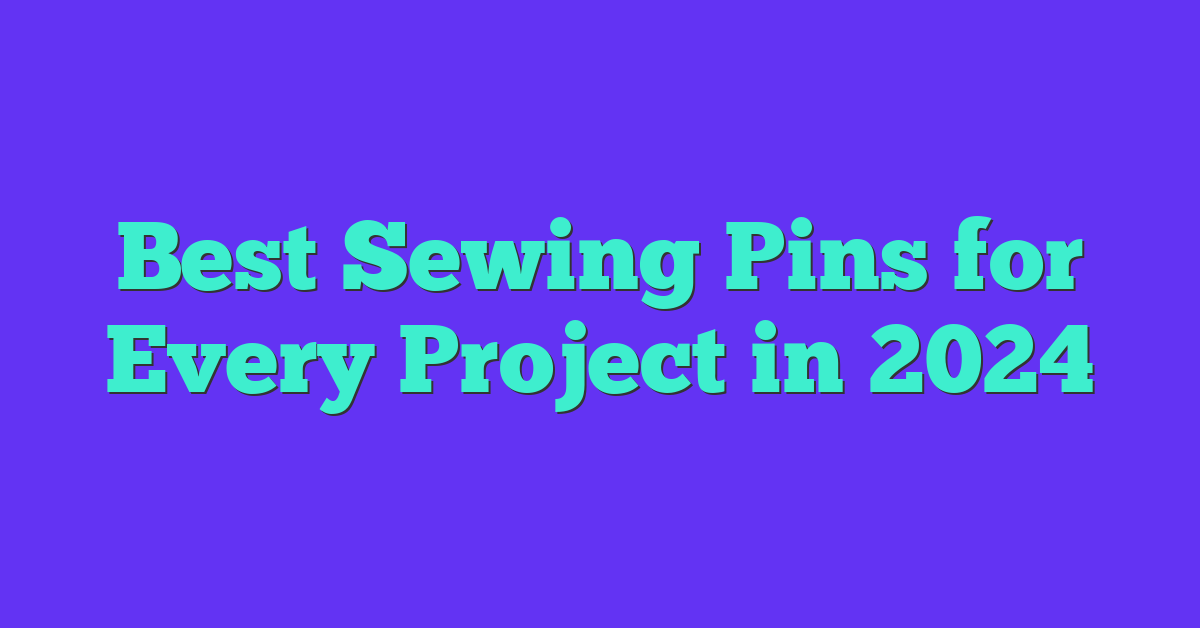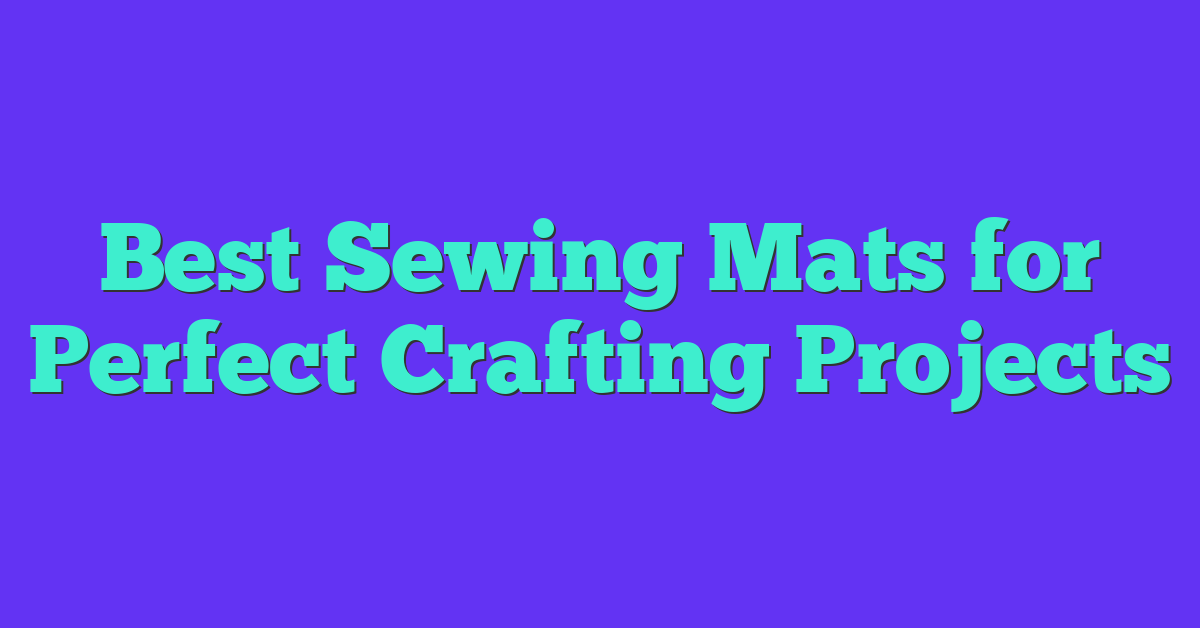Finding the best sewing machine can be a daunting task, especially if you’re new to sewing. With so many brands, models, and features available, it’s easy to get overwhelmed and end up with a machine that doesn’t meet your needs. In this article, I’ll share some tips on how to find the best sewing machine for your needs, whether you’re a beginner or an experienced seamstress.
Understanding sewing machines is the first step in finding the best one for you. Sewing machines come in different types, with different features and functions. Some are designed for basic sewing tasks, while others are more advanced and can handle complex projects. It’s important to know what you need your sewing machine for, so you can choose one that meets your requirements.
When choosing a sewing machine, there are several factors to consider, including the types of stitches it can make, the materials it can work with, its speed, and the features it offers. By taking the time to research and compare different models, you can find the best sewing machine for your needs and budget.
Key Takeaways
- Understand the different types of sewing machines and their features to choose the best one for you.
- Consider the types of stitches, materials, speed, and features when choosing a sewing machine.
- Research and compare different models to find the best sewing machine for your needs and budget.
Understanding Sewing Machines
As someone who loves sewing, I know that finding the right sewing machine can be overwhelming. There are so many different types of sewing machines out there, from mechanical to computerized machines. In this section, I will explain the different types of sewing machines and what you should consider when choosing the best one for you.
Mechanical Sewing Machines
Mechanical sewing machines are the most basic type of sewing machine. They are operated by a foot pedal and have a hand-cranked wheel that is used to move the needle up and down. These machines are great for beginners who are just learning to sew and don’t need any fancy features.
Computerized Sewing Machines
Computerized sewing machines are the most advanced type of sewing machine. They are operated by a computer and have a wide range of features, such as automatic needle threading, built-in stitches, and LCD screens. These machines are great for experienced sewers who need a machine that can handle complex projects.
Basic Sewing Machines
Basic sewing machines are a step up from mechanical machines. They have more features, such as adjustable stitch length and width, and often come with a variety of built-in stitches. These machines are great for intermediate sewers who want a machine that can handle a wider range of projects.
Heavy Duty Sewing Machines
Heavy duty sewing machines are designed for sewing thick fabrics, such as denim and leather. They have a powerful motor and can handle heavy-duty projects with ease. These machines are great for sewers who need a machine that can handle tough materials.
Quilting Machines
Quilting machines are designed specifically for quilting projects. They have a large throat space, which allows you to work on larger quilts, and often come with a variety of quilting stitches. These machines are great for quilters who need a machine that can handle large projects.
Embroidery Machines
Embroidery machines are designed for adding decorative stitching to fabric. They have a variety of built-in embroidery designs and can be used to create intricate designs on clothing, home decor, and more. These machines are great for sewers who want to add a personal touch to their projects.
Brother Sewing Machines
Brother is a popular brand of sewing machine that offers a wide range of machines, from basic to advanced. Two popular Brother sewing machines are the Brother CS7000X Computerized Sewing and Quilting Machine and the Brother XR9550 Sewing and Quilting Machine. These machines are great options for sewers who want a reliable machine from a trusted brand.
When choosing a sewing machine, consider what type of projects you will be working on and what features you need. Whether you’re a beginner or an experienced sewer, there is a sewing machine out there that is perfect for you.
Types of Stitches
As a sewing enthusiast, I know how important it is to have a sewing machine that offers a variety of stitch options. There are several types of stitches that you should consider when looking for the best sewing machine. Here are some of the most common types of stitches:
Straight Stitch
The straight stitch is the most basic and commonly used stitch. It is perfect for sewing seams, hems, and topstitching. Most sewing machines come with a straight stitch option, and it can be adjusted to different lengths.
Lock Stitch
The lock stitch is a type of stitch that is used to secure the ends of a seam. It is created by sewing forward and then backward over the same spot. This stitch is important because it prevents the seam from unraveling.
Buttonhole Stitch
The buttonhole stitch is used to create a secure opening for buttons. This stitch is created by making a series of closely spaced zigzag stitches. Many sewing machines have a buttonhole stitch option, and some even have an automatic buttonhole feature.
Zigzag Stitch
The zigzag stitch is a versatile stitch that can be used for a variety of purposes. It is commonly used for finishing raw edges, sewing stretch fabrics, and creating decorative effects. Most sewing machines come with a zigzag stitch option, and it can be adjusted to different widths and lengths.
Decorative Stitches
Decorative stitches are used to add embellishments to your sewing projects. They come in a variety of shapes and designs, such as flowers, stars, and hearts. Some sewing machines have a wide range of decorative stitch options, while others have just a few.

Blind Hem Stitch
The blind hem stitch is used to create a nearly invisible hem on pants, skirts, and other garments. It is created by sewing a straight stitch and then zigzagging over the edge of the fabric. This stitch is important because it gives your garments a professional look.
In conclusion, when looking for the best sewing machine, it is important to consider the types of stitches that it offers. A sewing machine with a variety of stitch options will allow you to be more creative with your sewing projects and achieve professional-looking results.
Sewing Machine Features
When choosing a sewing machine, it’s important to consider the features that will make your sewing experience comfortable and efficient. Here are some of the key features to look for:
Needle Threader
Threading the needle can be a frustrating task, especially for those with poor eyesight or shaky hands. A sewing machine with a built-in needle threader takes the hassle out of this process, making it quick and easy.
Bobbin
« Discover the Surprising Truth: The Shocking Differences Between Quilting Thread and Sewing Thread
Juki Sewing Machine Models: A Comprehensive Guide »
A bobbin is a small spool that holds the thread underneath the fabric. Look for a sewing machine with a top-loading bobbin, which is easier to access and less likely to jam than a front-loading bobbin.
Presser Feet
Presser feet hold the fabric in place while sewing and come in a variety of shapes and sizes for different tasks. Look for a machine with a few basic presser feet, such as a straight stitch foot, zigzag foot, and buttonhole foot. Some machines also come with specialty feet, like a walking foot for quilting or a zipper foot for inserting zippers.
LCD Screen
An LCD screen displays information about your stitch selection, thread tension, and more. It’s a helpful feature for beginners who may not be familiar with all the settings on their machine.
Foot Pedal
A foot pedal is used to control the speed of the machine. Look for a pedal with a comfortable grip and smooth action.
Thread Tension
Thread tension determines how tightly the upper and lower threads are pulled together. Look for a machine with adjustable tension settings so you can achieve the perfect stitch for your project.
Automatic Thread Cutter
An automatic thread cutter snips the thread at the end of a seam, saving you time and effort.
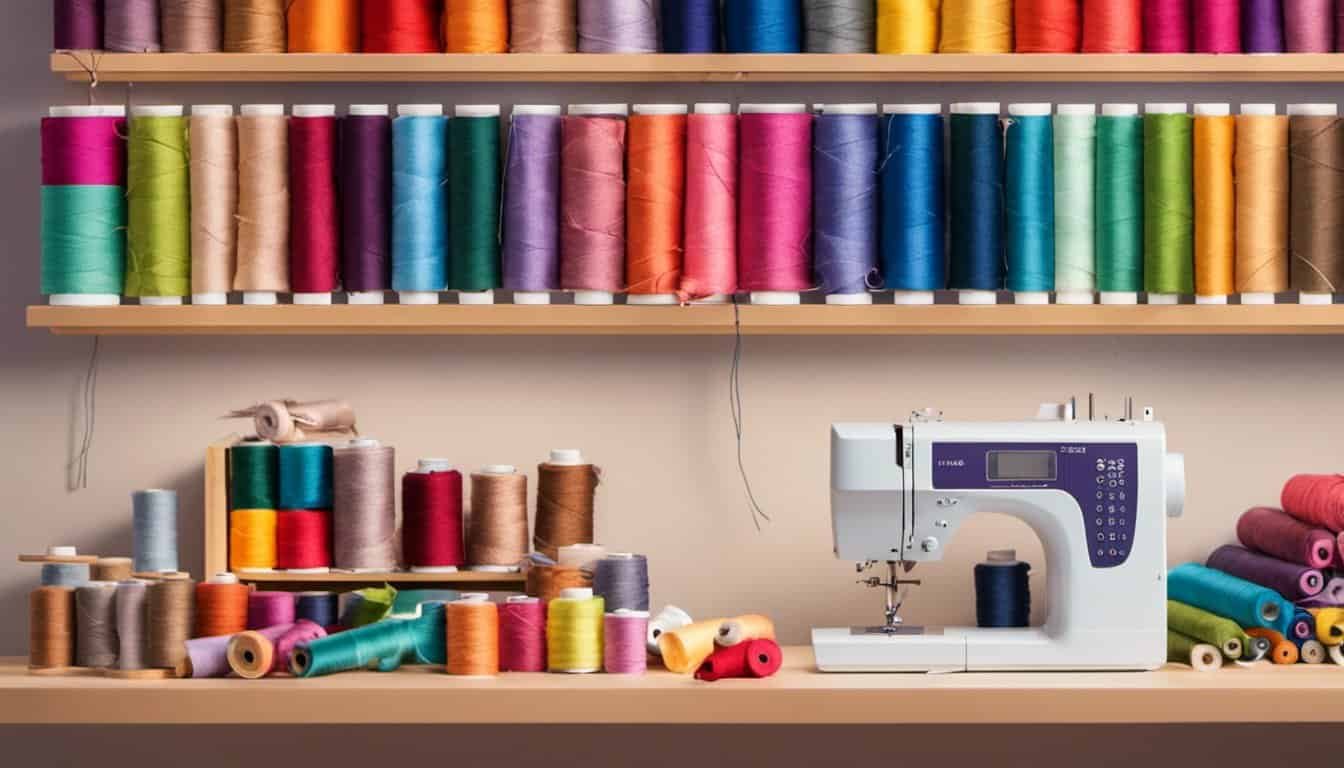
Free Arm
A free arm is a removable section of the sewing machine that allows you to sew small, circular items like sleeves and cuffs.
Extension Table
An extension table provides extra space for larger projects, like quilts or curtains.
Adjustment
Look for a machine with easy-to-use adjustment features, like stitch length and width, so you can customize your sewing to your liking.
Built-in Stitches
Many sewing machines come with a variety of built-in stitches, from basic straight and zigzag stitches to decorative stitches like scallops and flowers. Consider what types of projects you’ll be working on and choose a machine with the appropriate stitches.
Material Compatibility
When looking for a sewing machine, it’s important to consider the types of materials you will be working with. Not all machines are created equal, and some may struggle with certain fabrics. Here are some things to keep in mind:
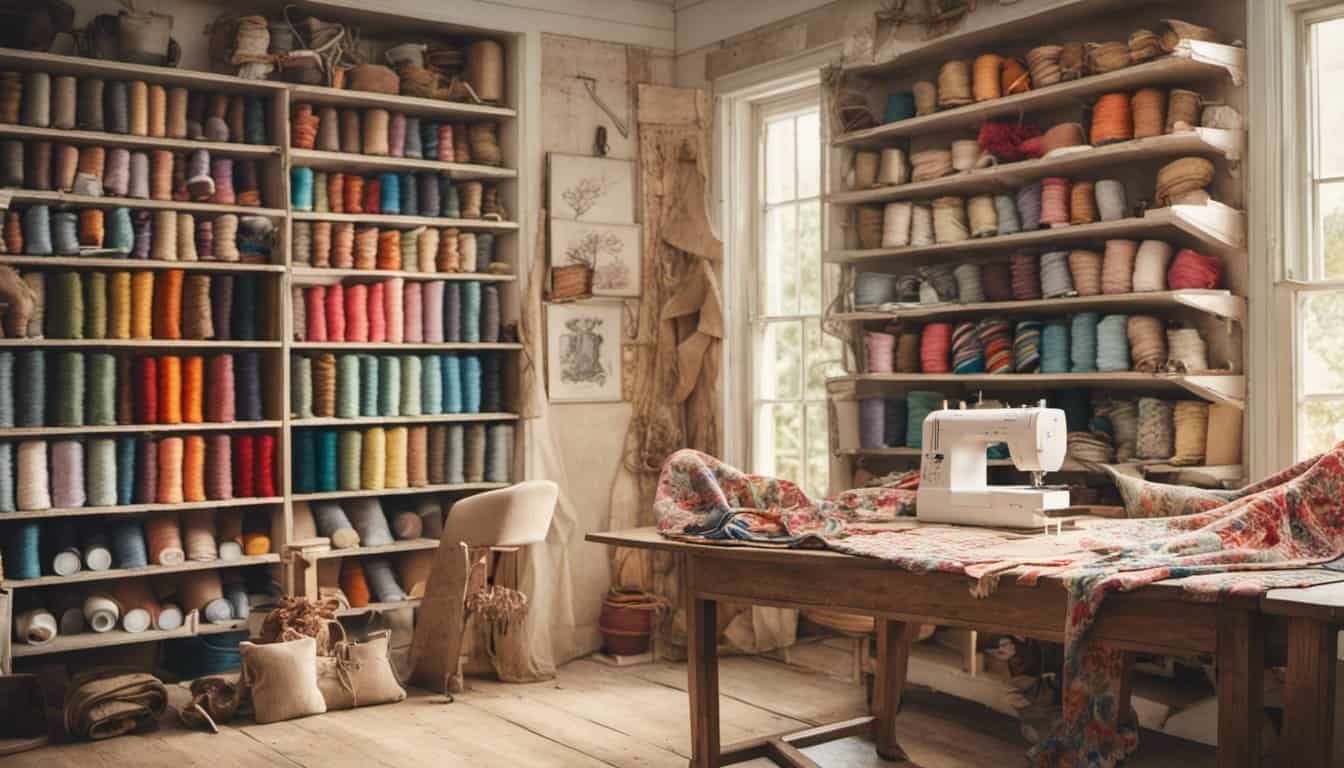
Fabric
Most sewing machines can handle lightweight fabrics like cotton and silk without any issues. However, if you plan on working with heavier fabrics like wool or velvet, you’ll want to look for a machine with a stronger motor and a sturdy frame.
Denim
Denim can be a tricky fabric to work with, especially if you’re using multiple layers. Look for a machine with a heavy-duty needle and a strong motor to power through the thick layers.
Quilts
If you plan on quilting, you’ll want a machine with a large throat space to accommodate the bulk of the quilt. Look for a machine with a quilting foot and a walking foot to ensure even stitches.
Canvas
Canvas is a tough fabric that requires a machine with a strong motor and a heavy-duty needle. Look for a machine with adjustable presser foot pressure to help feed the fabric through smoothly.
Leather
Sewing leather requires a machine with a strong motor and a heavy-duty needle designed specifically for leather. Look for a machine with adjustable presser foot pressure and a walking foot to ensure even stitches.
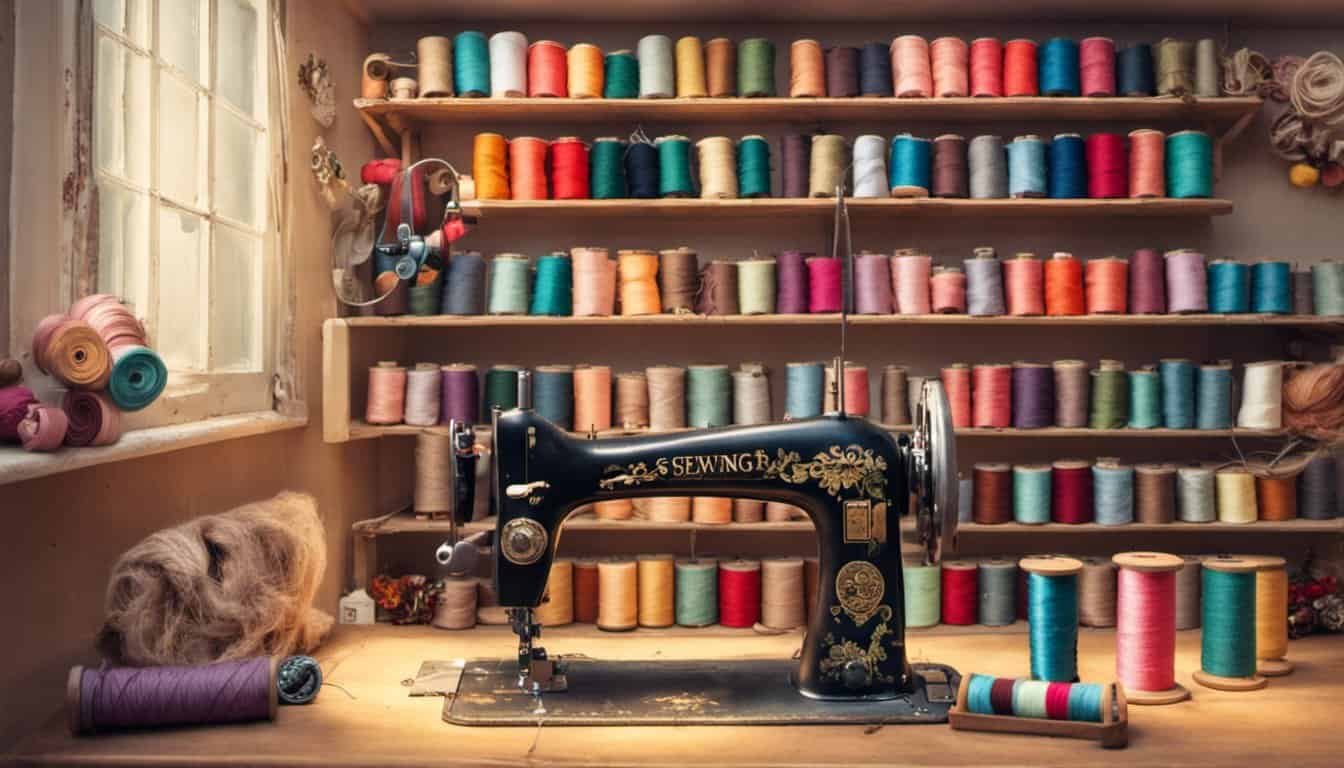
Thicker Fabrics
If you plan on working with a variety of thicker fabrics, look for a machine with adjustable presser foot pressure and a heavy-duty needle. A strong motor is also important to power through the layers.
Home Decor
If you plan on sewing home decor items like curtains or upholstery, look for a machine with a strong motor and a heavy-duty needle. Adjustable presser foot pressure and a walking foot will also come in handy for even stitches.
By considering the types of materials you will be working with, you can find a sewing machine that will meet your needs and help you create beautiful projects.
Sewing Machine Brands
When it comes to buying a sewing machine, there are many brands to choose from. Some of the most popular brands include Brother, Juki, Baby Lock, and Singer. Each brand has its own unique features and benefits, so it’s important to do your research and find the one that’s right for you.
One of the most popular sewing machine brands is Brother. The Brother CS7000X is a great option for beginners, offering a compact and computerized design with a range of features and accessories. The Brother XR9550 is another great option, offering both sewing and quilting capabilities.

Juki is another popular brand, known for its high-quality machines that are designed for heavy use. The Juki TL-2000Qi is a great option for quilters, offering a large work area and powerful motor.
Baby Lock is a brand that is known for its innovative features and ease of use. The Baby Lock Zest is a great option for beginners, offering a compact and lightweight design with a range of features.
Singer is another popular brand, known for its heavy-duty machines that are designed for tough fabrics and heavy use. The Singer Heavy Duty 4452 is a great option for those who need a machine that can handle heavy fabrics, while the Singer Quantum Stylist 9960 is a great option for those who need a wide range of features and capabilities.
Ultimately, the best sewing machine brand for you will depend on your individual needs and preferences. Consider factors such as your experience level, the types of projects you’ll be working on, and your budget when choosing a brand and model.
Sewing Projects
When it comes to sewing projects, the possibilities are endless. From making your own clothes to creating beautiful quilts, a good sewing machine is an essential tool for any seamstress. Here are some sewing projects that you can tackle with your new machine:

Making Clothes
One of the most satisfying things about sewing is being able to create your own clothes. With a good sewing machine, you can make everything from simple skirts and dresses to more complex items like jackets and pants. Look for patterns that are labeled “easy” or “beginner” if you’re just starting out.
Quilting
Quilting is another popular sewing project that requires a good machine. You’ll need a machine that can handle multiple layers of fabric, so look for one with a large throat space and a strong motor. You can find a wide variety of quilting patterns and designs online, or create your own using free-motion quilting techniques.
Embroidery
If you’re interested in adding decorative touches to your sewing projects, consider an embroidery machine. These machines can create intricate designs and patterns on fabric, and come with a variety of built-in designs to choose from. You can also purchase additional embroidery designs online.
Hems and Zippers
Even simple sewing projects like hemming pants or adding a zipper to a jacket can be made easier with a good sewing machine. Look for a machine with a variety of stitch options, including a straight stitch and a zigzag stitch, which are both essential for hemming and adding zippers.
Sleeves and Cuffs
Sewing sleeves and cuffs can be tricky, but a good machine can make it much easier. Look for a machine with a free arm, which makes it easier to sew small, curved pieces like sleeves and cuffs. You can also use a narrow hem foot to create a clean, professional-looking finish.

No matter what type of sewing projects you’re interested in, a good sewing machine is essential. Look for a machine that is versatile, easy to use, and can handle a variety of fabrics and projects. With the right machine, you’ll be able to tackle any sewing project with confidence.
Sewing Machine Speeds
When it comes to sewing machines, speed is an important factor to consider. The speed of a sewing machine is measured in stitches per minute (SPM). The higher the SPM, the faster the machine can sew.
However, it’s important to note that a higher SPM doesn’t necessarily mean a better sewing machine. The speed of a sewing machine should be balanced with other factors such as ease of use, durability, and stitch quality.
When shopping for a sewing machine, consider your skill level and the type of projects you will be working on. If you’re a beginner, a slower machine may be easier to handle. On the other hand, if you’re experienced and working on large projects, a faster machine may be more efficient.
Here are some general guidelines for sewing machine speeds:
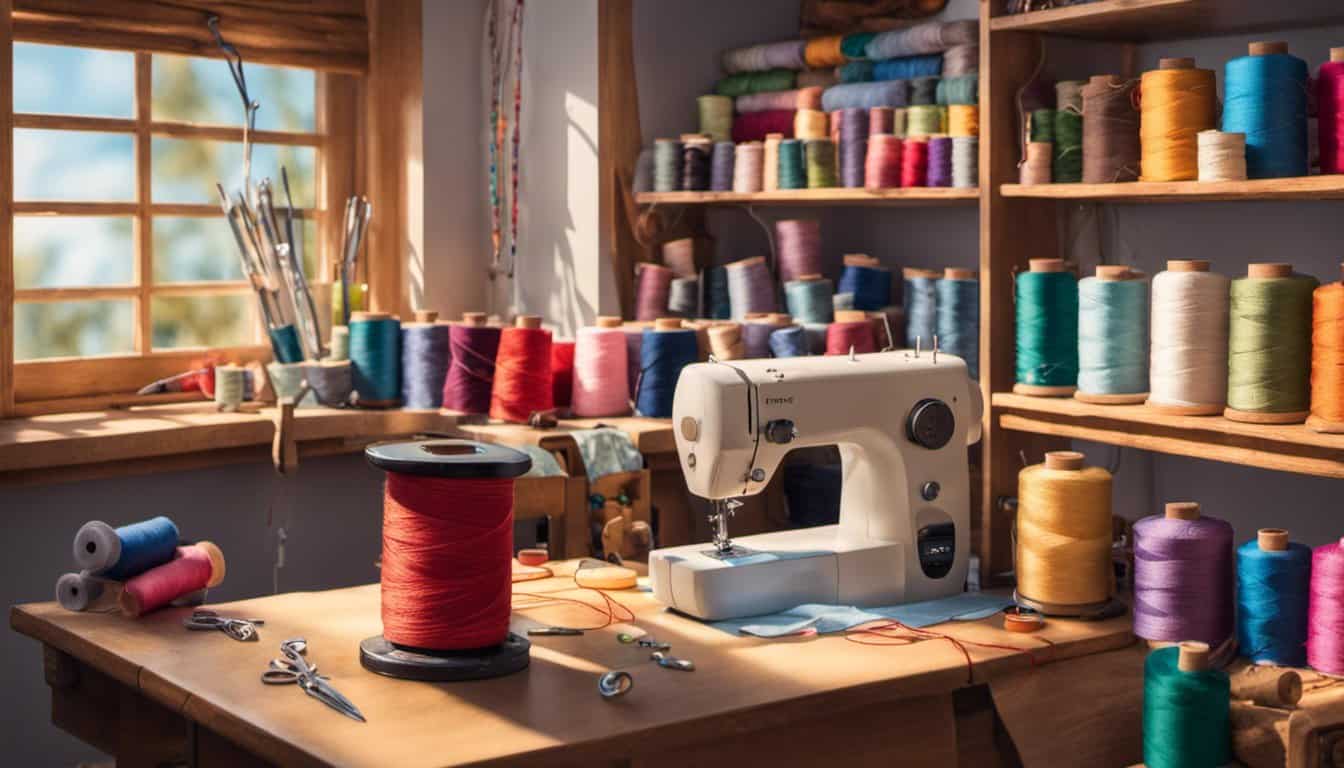
- Most home sewing machines have a maximum speed of around 800-900 SPM.
- Industrial sewing machines can have a maximum speed of up to 5,000 SPM.
- Quilting machines typically have a higher maximum speed than regular sewing machines.
It’s important to note that while a higher maximum speed can be beneficial, it’s not always necessary for every project. For example, when working with delicate fabrics, a slower speed may be more appropriate to prevent damage to the material.
In summary, sewing machine speed is an important factor to consider when shopping for a machine, but it should be balanced with other factors such as ease of use and stitch quality. Consider your skill level and the type of projects you will be working on when selecting a machine with an appropriate maximum speed.
Choosing the Best Sewing Machine
When it comes to choosing the best sewing machine, there are a lot of factors to consider. As someone who has been sewing for years, I know that it can be overwhelming to navigate the different types of machines and features available. But don’t worry, I’m here to help!
First and foremost, it’s important to consider your budget. Sewing machines can range in price from under $100 to several thousand dollars. If you’re just starting out or on a tight budget, there are plenty of great options available at an affordable price. For example, the Magicfly Mini Sewing Machine is a popular choice for beginner sewists due to its ease of use and user-friendly design.
If you’re an advanced sewer or looking to tackle more complex projects, you may want to invest in a more advanced machine with additional features like an overlock stitch. Brands like Brother and Janome offer a range of machines for all skill levels and budgets.

Another important factor to consider is the type of sewing you plan to do. If you primarily sew by hand and only need a machine for occasional use, a basic model may be sufficient. However, if you plan to use your machine frequently or for more complex projects, you’ll want to choose a machine with the necessary features and capabilities.
Ultimately, the best sewing machine for you will depend on your individual needs and preferences. Take the time to do your research and read reviews from other sewers to find the perfect machine for your needs. With the right machine and a little practice, you’ll be creating beautiful projects in no time!
Sewing Machine Accessories
When it comes to sewing machines, accessories can make all the difference. Here are some of the must-have sewing machine accessories that I recommend:
Presser Feet
Presser feet are essential for any sewing project. They help to keep the fabric in place and ensure that your stitches are even. There are many different types of presser feet available, including ones for zippers, buttons, and quilting.
Bobbins
Bobbins are small metal parts that hold the thread in place. They are essential for any sewing project, and it’s always a good idea to have a few extra on hand. Make sure to choose bobbins that are compatible with your specific sewing machine.

USB Port
If you’re looking for a more high-tech sewing machine, consider one with a USB port. This will allow you to connect your machine to your computer and download new patterns and designs. It’s a great way to keep your sewing projects fresh and exciting.
Cleaning and Maintenance Kit
To keep your sewing machine in top condition, it’s important to clean and maintain it regularly. A cleaning and maintenance kit will include everything you need to keep your machine running smoothly, including oil, brushes, and a lint brush.
Sewing Machine Cover
Finally, a sewing machine cover is a must-have accessory to protect your machine from dust and debris when not in use. You can purchase one or make your own using a pattern and some fabric.
Overall, these are just a few of the many sewing machine accessories available. Whether you’re a beginner or an experienced seamstress, having the right accessories can make all the difference in your sewing projects.
Buying a Sewing Machine Online
As someone who has bought multiple sewing machines online, I can attest that it can be a convenient and cost-effective way to find the perfect machine for your needs. However, it can also be overwhelming with so many options available. Here are some tips to help you navigate the process:
Research, Research, Research
Before making any purchase, it’s essential to do your research. Read reviews from other customers who have bought the same machine you’re considering. Look for detailed reviews that include pros and cons, as well as any issues the customer may have had with the machine. Don’t just rely on the reviews on the seller’s website; look for reviews on other websites as well.
Compare Prices and Features
One of the benefits of buying a sewing machine online is the ability to compare prices and features easily. Use websites like Amazon to compare prices and features of different models. Look for machines that have the features you need, such as a variety of stitches, automatic needle threading, and easy-to-use controls.
Check the Seller’s Reputation
When buying online, it’s important to check the seller’s reputation. Look for sellers with high ratings and positive reviews. If you’re buying from a third-party seller on a site like Amazon, check their ratings and reviews as well.
Look for Deals and Discounts
Online retailers often have deals and discounts that you won’t find in-store. Look for sales, coupon codes, and other promotions that can help you save money.
Read the Return Policy
Before making a purchase, make sure to read the seller’s return policy carefully. If the machine arrives damaged or doesn’t meet your expectations, you’ll want to know how to return it. Some sellers may have strict return policies, while others may allow you to return the machine for a full refund.
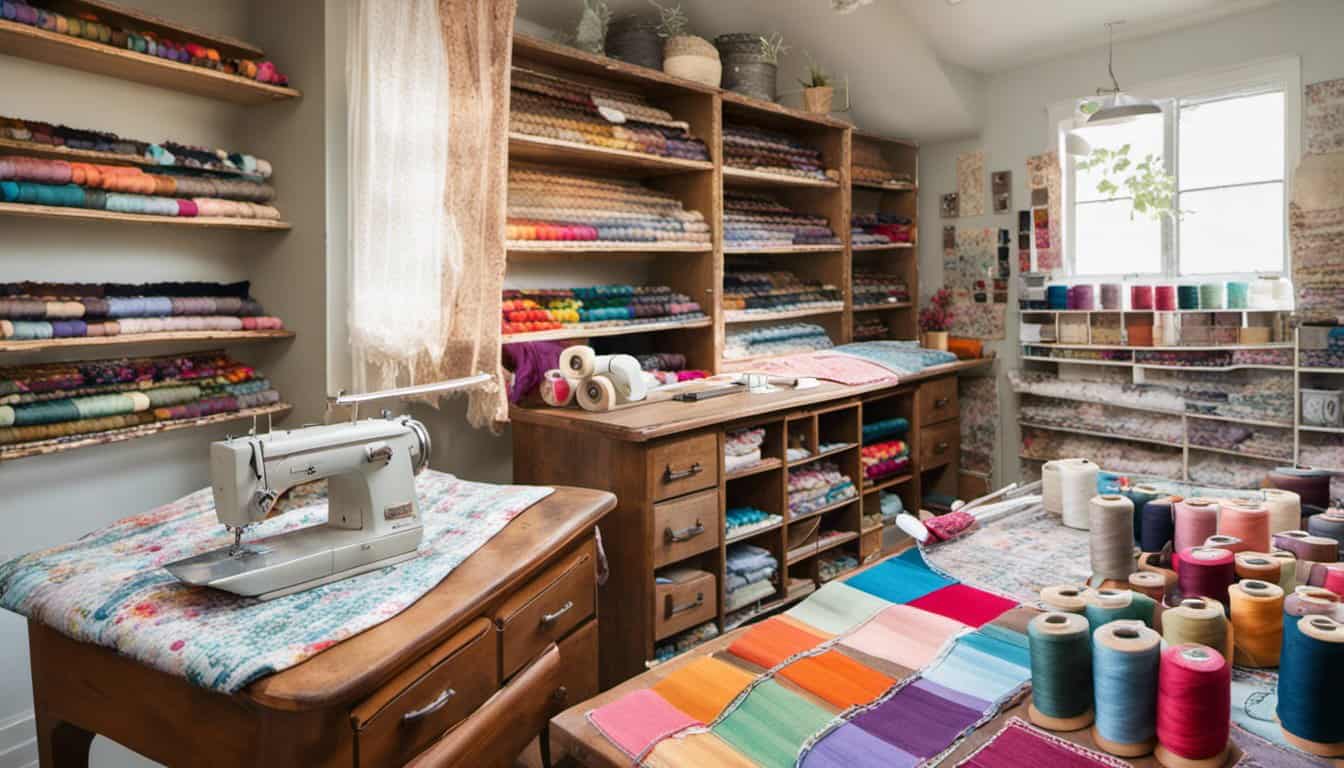
By following these tips, you can find the perfect sewing machine online that meets your needs and fits your budget.
Frequently Asked Questions
What are some top-rated sewing machine brands?
There are several top-rated sewing machine brands to choose from. Some of the most popular brands include Singer, Brother, Janome, and Bernina. These brands are known for producing high-quality machines that are reliable and durable.
What factors should I consider when buying a sewing machine?
When buying a sewing machine, there are several factors to consider. First, you should think about your skill level and what types of projects you want to work on. You should also consider the size and weight of the machine, as well as the number of stitches and other features it offers.
Are there any sewing machines that are particularly good for beginners?
Yes, there are several sewing machines that are great for beginners. Look for machines that are easy to use and have simple controls. Some good options include the Brother XM2701, Singer Start 1304, and Janome Graceful Gray Basic.
What are some features to look for in a sewing machine for home use?
When looking for a sewing machine for home use, there are several features to consider. Look for machines that offer a variety of stitches, including straight, zigzag, and decorative stitches. You should also look for machines that have adjustable stitch length and width, as well as automatic needle threading and a drop-in bobbin system.

How can I determine which type of sewing machine is best for my needs?
To determine which type of sewing machine is best for your needs, you should consider what types of projects you want to work on and your skill level. If you are a beginner, you may want to start with a basic machine that is easy to use. If you are more experienced, you may want a machine that offers more advanced features.
Is there a quiz or guide to help me choose the right sewing machine for me?
Yes, there are several quizzes and guides available online that can help you choose the right sewing machine for your needs. These resources can help you determine what features you need and what type of machine is best for your skill level. Some popular guides include the Sewing Machine Buying Guide from Consumer Reports and the Sewing Machine Quiz from Sewing Machines Plus.

